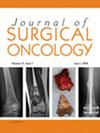CT Scans Understage Lymph Nodes in Gastric and Gastroesophageal Adenocarcinoma
Abstract
Background and Objectives
The presence of lymph node metastases in patients with gastric and gastroesophageal junction (GEJ) adenocarcinoma provides prognostic information and guides treatment decisions. We sought to determine the sensitivity of computed tomography (CT) imaging for clinical nodal staging in patients with resectable gastric and GEJ adenocarcinoma and determine a lymph node size cut-off to optimize diagnostic accuracy.
Methods
We performed a retrospective review of patients who underwent curative-intent resection for gastric or GEJ adenocarcinoma at our institution between 2010 and 2023. We reviewed CT scan images performed immediately before resection and measured lymph nodes in the short axis to identify patients with lymph nodes larger than the radiologic upper limit of normal. We compared histopathologic data from resection specimens to CT scans to determine pathologic concordance for metastatic involvement of lymph nodes and calculated the sensitivity and specificity of CT scans to identify nodal metastases. We used the largest lymph node measurement from each scan to construct a receiver operating characteristic (ROC) curve and calculated Youden's J Index to determine the optimal lymph node size cut-off.
Results
We identified 192 consecutive patients who underwent resection during the study period and had preoperative CT scans available for review. 72 patients (38%) had diffuse or mixed type tumors, and 85 patients (44%) had intestinal-type tumors. 157 patients (82%) underwent neoadjuvant chemotherapy or chemoradiation. 110 patients (57%) had pathologic node-positive disease and in this cohort, 27 patients (25%) had lymph nodes deemed radiographically enlarged. The sensitivity of preoperative CT scans for nodal metastases was 25%, and specificity was 83%. Based on the ROC curve, an optimal lymph node size cutoff of 6.5 mm was identified. At this cutoff, the estimated sensitivity was 47%, and the estimated specificity was 72%. When patients were stratified by Lauren histology, the AUC for intestinal-type tumors was significantly better than for diffuse or mixed-type tumors (p = 0.02). The area under the ROC curve for patients with diffuse or mixed type tumors was 0.51 indicating lymph node size on CT scan was no better than random chance for diagnosis of lymph node metastases.
Conclusions
CT scans are not sensitive to identify nodal metastases in gastric and GEJ adenocarcinoma using current radiologic guidelines. While a lower lymph node size cutoff may improve sensitivity, this does not benefit patients with diffuse or mixed-type tumors. Since CT scans understage a large proportion of patients with gastric and GEJ cancers, techniques to improve clinical nodal staging in this population are needed.


 求助内容:
求助内容: 应助结果提醒方式:
应助结果提醒方式:


